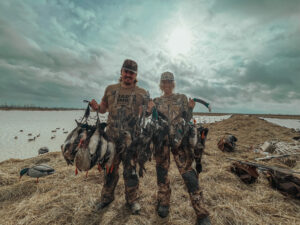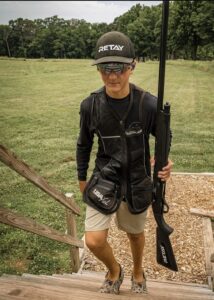
By: T.J. Rademacher

Through my journey as a waterfowl hunter, I have gradually moved farther to the dark side. If you pay attention to the industry the Puddle Duck and Goose hunters get all the hype. I’m not saying having big groups of Mallards and Canadas back pedaling at 15 yards isn’t exciting. I love it and if the opportunity arises for any kind of waterfowl hunt I’m there. Unfortunately, where I grew up the puddle duck hunting wasn’t all that consistent and with limited amounts of public water available the opportunities really dried up after the first few weeks of the season as far as puddle ducks went. Here in North Carolina we are really known for the Divers. I remember the first time my dad took me out to the Outer Banks. We wanted to try something different. We went with a local guide to see what the lay of the land was like. It was like a different planet. Big boats, Gear intensive, ultra-big water, and large bird numbers. I was and always will be hooked after that first Bluebill. After that I said “I’m going to figure this out. This is what I want to get good at”, and I did. Even though I am an experienced diver hunter now I still get humbled by all the variables that go into a successful diver hunt. It’s what keeps bringing me back. Chasing that perfect Bluebill canvasback redhead limit.
I learned a lot of stuff the hard way. I don’t think you should necessarily, so I’m going to tell you how I do things and what I think is best. Feel free to modify your plan for your area. What I’m going to tell you is how I’ve found success personally. There are many recipes for the secret sauce, and they can work in different areas better than others. This is a list of the main ingredients. Boats/safety, Decoys/rigging, and scouting.
Diver hunting typically takes place in the later parts of season. These birds are hearty and only move when the food source they are on is made unreachable by weather conditions. It’s like the puddle duck migration just in a different medium. Often, the best diver hunting takes place on vast expanses of open water. During the winter months the weather can make these areas a death trap for people who are not experienced or not paying attention. The first key ingredient to hunting is knowing the limits of your gear. I ran a 16 ft. Jon boat in my teens and early twenties, and I have had some really close calls pushing the limits. Some of the stuff I did makes old me shake my head and wonder what I was thinking. You should never have to look over at a person in your boat and say. “If something bad happens stay with the boat” and really mean every word of it. Don’t write checks your hull can’t cash. Always remember it’s not just you that you’re responsible for.
Boats are an integral part of diver hunting. In my opinion you should have as much boat as you can afford and not so much that it limits you in the areas you frequently hunt. I would say start looking at boats 18-20 ft. and up. You want to be able to get out in the rough water and be safe during weather you can reasonably expect to operate in safely. Observe what others are doing that are safe and successful. You will quickly see what type of rig is going to do the job for you. I run a 22 ft. StarCraft V-hull with a center console that I retrofitted to fit my needs. I don’t have mega bucks into it, and it is a safe, comfortable boat to haul gear for shore/ stake blind hunts and layout hunt out of with 3-4 people. This is what I have found is the best compromise for what I do and the conditions I face most often. I would go bigger than you think you need when selecting a hull. I’ve never found myself complaining about extra space and when the Weather turns, you’ll be able to get back safely and with confidence.

Decoys and rigging are a huge part of Diver hunting. As far as decoys go you can never own too many. You can only put out too few or too many. I know a guide that runs 150 dozen decoys at a time. Yes, you read that right. He has a very unique situation though, so he can leave his rig out almost all season. He wrecks them. However, most of us must be more mobile than that and also, the average guy can’t haul or afford that many decoys. My starting point would be acquiring 6-10 dozen decoys. This may seem daunting when you start looking at the price tags of commercially available decoys. While I recommend an either all foam or foam filled decoy if you can afford them, you shouldn’t be discouraged if you can’t afford that kind of stuff at first. I started repainting old decoys into divers when I was in my teens and continued to do so until I recently shifted to buying small lots of all foam decoys. It will not take you long to build a spread this way and it is very affordable to get started. Don’t worry about the species you are repainting just get the colors right and you will kill birds. I’ve watched more birds die over repainted hot buy mallard specials than I can recall.
You will quickly come to realize that the amount of time it takes to pick up 6 dozen single rigged decoys can really add on to the end of a hunt or be a huge drag when you realize you need to move 500 yards to get to where the birds want to be. The key to getting set up and picking up fast is by using multiple rig decoy rigging. I use a combination of net rigs and long lines to put out and retrieve lots of decoys very quickly. I’ll go into detail on this in my next article but for now ill loosely define the two methods. A net rig is just what it sounds like. It’s a net that is anchored with multiple decoys attached. This mimics a raft of birds closely packed together on open water. The net is retrieved and deployed by pulling it in and out of the boat. Stretching it with the use of multiple or singe anchors depending on the style of net rig you are using. Longlines are a main line with decoys attached to it that are weighted on both ends. There are different schools of thought on how to make the rig material wise, but the traditional way is a #120 tarred line for your drops and main line. Feel free to change it up if you think you need more than that. I would not go less that this because of the increased risk of tangles. You’ll need anchors for both nets and longlines. You can buy them or make them it doesn’t matter as long as they are heavy enough for your conditions. There are other styles such as layout hunting that I’ll get into in other installments on diver hunting that involve both longlines and net rigs offshore in deep water but for now this is where to start. I’m a big proponent of the crawl walk run method. You really don’t just casually get into layout boats.

After you’ve got all the gear or while you are compiling it you need to treat diver scouting just like you would finding birds in a field or anywhere else. This can be accomplished from the boat or truck depending on how much of your local water you can get your eyes on from shore. On the sounds in North Carolina, you’ve got really no choice but to get out and ride on the open water until you find them and get an idea of what they are up to. Same goes for the great lakes. On Large reservoirs it’s a little easier because the spots they are going to be are a little more finite. If you can’t get on the X whether it be because you can’t get to them or someone else is on it, you need to have a backup plan to get in their way and run traffic. Identify where they are going and be ready to set up accordingly. It pays to have already thought through your options. Second plans are like second opinions, always have one.
Diver hunting is work and it’s not for the faint of heart. You’ve got to really want it. I recommend going with a guide or someone you know who is into it first to see if it’s for you or not. If you are young or on a budget compile your gear over time or split the costs of gear among a trusted group of friends. Once you get the bug you won’t be able to stop thinking about it and it will take you all over the place trying to get after these open water birds.
Tell people where you are going and what time you’re going to be back. It could save your life.
T




